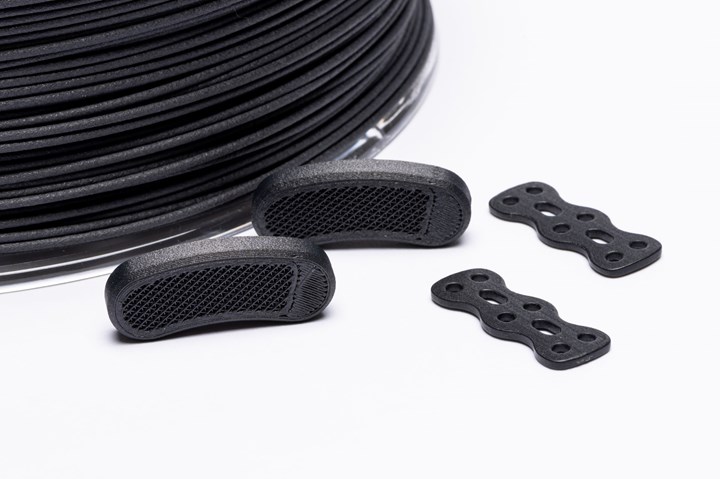Carbon Fiber Reinforced PEEK for Medical Implants
Vestakeep is available at two levels of carbon fiber content and appropriate for long-term surgical implants.
Evonik is introducing a new carbon-fiber reinforced polyetheretherketone (PEEK) filament, for use in 3D printed medical implants. It be processed in common extrusion-based 3D printing technologies such as fused filament fabrication (FFF).
Vestakeep iC4612 and Vestakeep iC4620 feature 12% and 20% carbon fiber content, respectively. The two grades offer a choice of material depending on the required strength and flex properties of 3D printed implants such as bone plates and other reconstructive prostheses.

Carbon fiber reinforced PEEK filament for printing long term surgical implants. Photo Credit: Evonik
Carbon fibers add strength to the filament products, while PEEK adds ductility. Other benefits, according to Evonik, include the ability to define the alignment of carbon fibers during the printing process, biocompatibility and avoiding X-ray artifacts.
With a diameter of 1.75 mm, Vestakeep iC4612 and iC4620 are supplied on 500 g and 1,000 g spools that can be used directly in standard FFF/FDM 3D printers for PEEK materials.
“No other application field showcases more the advantages of 3D printing, such as individualization or design freedom, than medical technology,” says Marc Knebel, head of medical systems at Evonik. “In trauma applications, for instance, 3D printed solutions offer an enormous time advantage over traditionally manufactured medical devices. It is conceivable that patient-specific solutions can be manufactured within two or three days, significantly improving the recovery phase.”
Related Content
-
Lanxess and DSM Engineering Materials Venture Launched as ‘Envalior’
This new global engineering materials contender combines Lanxess’ high-performance materials business with DSM’s engineering materials business.
-
What's the Allowable Moisture Content in Nylons? It Depends: Part 2
Operating within guidelines from material suppliers can produce levels of polymer degradation. Get around it with better control over either the temperature of the melt or the barrel residence time.
-
Scaling Up Sustainable Solutions for Fiber Reinforced Composite Materials
Oak Ridge National Laboratory's Sustainable Manufacturing Technologies Group helps industrial partners tackle the sustainability challenges presented by fiber-reinforced composite materials.















